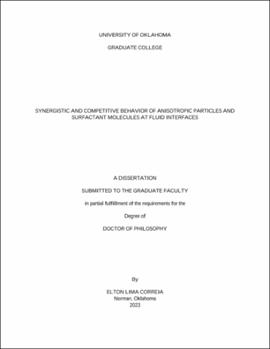| dc.description.abstract | Colloidal systems are a common feature in different application domains, from complex underground frameworks such as petroleum recovery and water remediation to industrialized consumer products such as cosmetics and paint. These systems usually consist of multiple components, such as nanoparticles, polymers, surfactants, and ions exhibiting unique properties that are different from those of simple fluids. In addition, in many applications involving the water-energy nexus, these complex fluids come in contact with surfaces and interfaces. For instance, an enhanced oil recovery operation usually consists of flooding a multicomponent fluid (e.g., aqueous solution of surfactants and polymers) through a reservoir rock that has heterogeneous porosity and anisotropic permeability. Another example is the treatment of produced water generated from the oil industry to separate the organic contaminants that are stabilized by surface-active species present in both phases. Given the range of phenomena that take place simultaneously, from the dynamic wetting of complex fluids on a solid surface to interfacial stresses and deformations at a fluid interface, advancing our understanding of the key factors that govern the interactions present in such systems and their resulting properties, will lay the foundation for the engineering of complex interfacial systems with a tailored set of properties.
To decode the behavior of multicomponent fluidic systems, it is crucial to understand the role of components present, both individually and synergistically, in the governing physics. For instance, surfactants, as amphiphilic molecules, populate the interface providing interfacial stability via a reduction in interfacial tension. In contrast, colloidal particles stabilize an interface by occupying the contact area between the two fluids. Hence, attributes such as particle size and surface chemistry can be used to control their position at the interface and the resulting reduction in the free energy. Moreover, particles encountered in real-world applications, such as those encountered in foam flotation for ore recovery, often diverge from the case of isotropic homogeneous particles; thus, it is crucial to understand the impact of heterogeneities present in such scenarios, on the resulting interactions, by studying model particles. These include particles that are rough and possess anisotropies either in shape or surface chemistry. A classic example of a chemically anisotropic particle is the Janus Particle (JP), named after the two-face Roman God. The Janus motif brings unique functionalities to a multicomponent system, augmenting the number of variables that can be tuned to achieve the desired outcomes. Although there is some literature with respect to the dynamics of particles and surfactants at interfaces, little information is available on mixed systems, especially for heterogenous and anisotropic, yet technologically relevant, particles.
The present work is dedicated to probing the roles different surface-active species (i.e., surfactants and nanoparticles) paly in resulting interfacial phenomena such as surface pressure, mechanical properties when subjected to dilational or shear stresses, and the stability of multicomponent fluidic systems. We investigate various features that can be employed in tuning the competitive vs. synergistic behavior of species that make up the system and determine the role non-idealities play in tuning the properties of the populated interface and stability of the interfacial systems. The knowledge base achieved from this PhD work, will equip us with a fundamental understanding of the key attributes in design and engineering of solutions to address real-life challenges in a broad range of applications from wastewater remediation to increasing the shelf-life of a product. | en_US |
